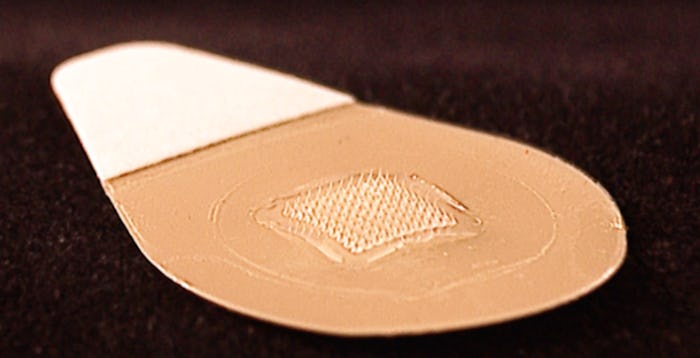Despite the fact that it's absolutely critical (and potentially life-saving), it's still hard to get excited about getting a vaccination — especially for parents whose kids need the dreaded shots, too. So, while little ones everywhere wail at the prospect of the prick, researchers have been busy developing a game-changing (and, again, potentially life-saving) solution. Behold, the resulting recent alternatives to shots, which could help kids who are afraid of getting shots themselves.
The most recent development — and perhaps most exciting — is a Band-Aid-like patch that administers vaccines for illnesses like the flu, no painful skin jab required. Researchers are working on applying the technology to a whole host of illnesses that affect both kids and adults in the United States and beyond.
Shots have been the standard when it comes to vaccines for a long time. But the prick of the needle is a painful prospect for kids in particular. And adults sometimes aren't much more enthused, if the dismal turnout for flu shots is any indication. According to the Centers for Disease Control and Prevention (CDC), just shy of 60 percent of U.S. kids were vaccinated against the flu during the 2015-16 season; The vaccination rate among adults was even more dismal at about 40 percent. The flu has killed between 12,000 and 56,000 people annually since 2010, a stat that underscores the monumental importance of vaccinations.
But the "microneedles" alternative to the shot has the potential to change this outcome for the better — and it's just one of many medical breakthroughs that could help to take the fear out of going to the doctor for kids.
The Flu Vaccine Patch
Clinicians at Emory University recently conducted a 100-person trial of the aforementioned "bandage" that contains a flu vaccine a team from Georgia Tech University developed. The findings, published in the medical journal The Lancet, showed that it worked just as well as the traditional prick, but operated without the pain. Some participants were even able to administer the vaccine themselves by sticking the patch, whose tiny "needles" are the vaccine, to their wrists, according to The Los Angeles Times.
It was the first time that such a patch had been used to administer the flu vaccine to humans, and more testing is needed before the shot alternative can become widely available. Still, Georgia Tech engineer and team leader Mark Praushitz envisions a future in which parents can pick up a pack of them at the store and give them to their entire families at home, he said in Georgia Tech video about the awesome invention.
The Patch To Immunize Against Other Illnesses
The news that the microneedle patch could work to vaccinate children and adults alike against the common flu is pretty cool. But researchers are also working on applying it to other vaccines, like those for measles, rubella, and polio, NBC News reported. What's more, they've even experimented with two serious modern-day nightmares: the Zika virus and Ebola. The patch could be even more effective at reaching populations in low- and middle-income countries because it "costs less, is easier to transport, doesn’t require refrigeration, can be self-administered and doesn’t generate sharps waste," Karen Kaplan wrote for The Los Angeles Times.
The Jet Injector
There's another way to get the flu vaccine besides heading to the doctor for a shot, but kids actually aren't eligible to use it. According to the CDC, the so-called jet injector, which employs a "high-pressure, narrow stream of fluid to penetrate the skin" is approved only for individuals between 18 and 64 years of age. Perhaps simply learning about this cool alternative, though, will help to ease kids' nerves about getting a shot (or, sometime soon, the patch). After all, it shows just how awesome the idea of a quick prick protecting a person from sickness really is.
No matter what form they take, though, it's imperative that kids do get their vaccinations. Despite what the anti-vaxxers say, the fact that experts are working so diligently on alternative modes to administer shots drives home the point that they save lives and should be accessible to as many people as possible.
